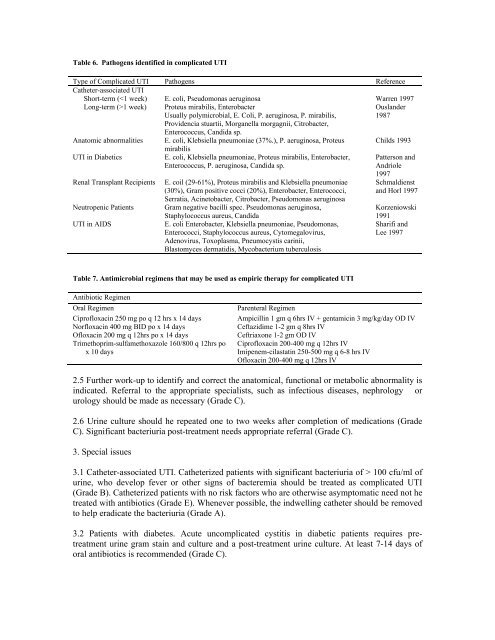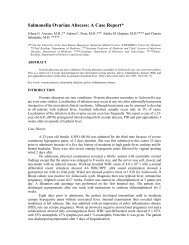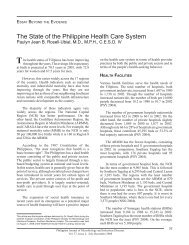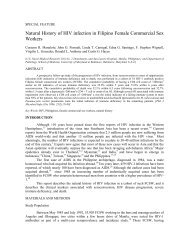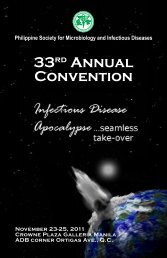The Philippine Clinical Practice Guideline on the Diagnosis and ...
The Philippine Clinical Practice Guideline on the Diagnosis and ...
The Philippine Clinical Practice Guideline on the Diagnosis and ...
You also want an ePaper? Increase the reach of your titles
YUMPU automatically turns print PDFs into web optimized ePapers that Google loves.
Table 6. Pathogens identified in complicated UTI<br />
Type of Complicated UTI Pathogens Reference<br />
Ca<strong>the</strong>ter-associated UTI<br />
Short-term (1 week) Proteus mirabilis, Enterobacter<br />
Usually polymicrobial, E. Coli, P. aeruginosa, P. mirabilis,<br />
Providencia stuartii, Morganella morgagnii, Citrobacter,<br />
Enterococcus, C<strong>and</strong>ida sp.<br />
Anatomic abnormalities E. coli, Klebsiella pneum<strong>on</strong>iae (37%.), P. aeruginosa, Proteus<br />
mirabilis<br />
UTI in Diabetics E. coli, Klebsiella pneum<strong>on</strong>iae, Proteus mirabilis, Enterobacter,<br />
Enterococcus, P. aeruginosa, C<strong>and</strong>ida sp.<br />
Renal Transplant Recipients E. coil (29-61%), Proteus mirabilis <strong>and</strong> Klebsiella pneum<strong>on</strong>iae<br />
(30%), Gram positive cocci (20%), Enterobacter, Enterococci,<br />
Serratia, Acinetobacter, Citrobacter, Pseudom<strong>on</strong>as aeruginosa<br />
Neutropenic Patients Gram negative bacilli spec. Pseudom<strong>on</strong>as aeruginosa,<br />
Staphylococcus aureus, C<strong>and</strong>ida<br />
UTI in AIDS E. coli Enterobacter, Klebsiella pneum<strong>on</strong>iae, Pseudom<strong>on</strong>as,<br />
Enterococci, Staphylococcus aureus, Cytomegalovirus,<br />
Adenovirus, Toxoplasma, Pneumocystis carinii,<br />
Blastomyces dermatidis, Mycobacterium tuberculosis<br />
Table 7. Antimicrobial regimens that may be used as empiric <strong>the</strong>rapy for complicated UTI<br />
Ousl<strong>and</strong>er<br />
1987<br />
Childs 1993<br />
Patters<strong>on</strong> <strong>and</strong><br />
Andriole<br />
1997<br />
Schmaldienst<br />
<strong>and</strong> Horl 1997<br />
Korzeniowski<br />
1991<br />
Sharifi <strong>and</strong><br />
Lee 1997<br />
Antibiotic Regimen<br />
Oral Regimen Parenteral Regimen<br />
Ciprofloxacin 250 mg po q 12 hrs x 14 days Ampicillin 1 gm q 6hrs IV + gentamicin 3 mg/kg/day OD IV<br />
Norfloxacin 400 mg BID po x 14 days<br />
Ceftazidime 1-2 gm q 8hrs IV<br />
Ofloxacin 200 mg q 12hrs po x 14 days<br />
Ceftriax<strong>on</strong>e 1-2 gm OD IV<br />
Trimethoprim-sulfamethoxazole 160/800 q 12hrs po Ciprofloxacin 200-400 mg q 12hrs IV<br />
x 10 days<br />
Imipenem-cilastatin 250-500 mg q 6-8 hrs IV<br />
Ofloxacin 200-400 mg q 12hrs IV<br />
2.5 Fur<strong>the</strong>r work-up to identify <strong>and</strong> correct <strong>the</strong> anatomical, functi<strong>on</strong>al or metabolic abnormality is<br />
indicated. Referral to <strong>the</strong> appropriate specialists, such as infectious diseases, nephrology or<br />
urology should be made as necessary (Grade C).<br />
2.6 Urine culture should he repeated <strong>on</strong>e to two weeks after completi<strong>on</strong> of medicati<strong>on</strong>s (Grade<br />
C). Significant bacteriuria post-treatment needs appropriate referral (Grade C).<br />
3. Special issues<br />
3.1 Ca<strong>the</strong>ter-associated UTI. Ca<strong>the</strong>terized patients with significant bacteriuria of > 100 cfu/ml of<br />
urine, who develop fever or o<strong>the</strong>r signs of bacteremia should be treated as complicated UTI<br />
(Grade B). Ca<strong>the</strong>terized patients with no risk factors who are o<strong>the</strong>rwise asymptomatic need not he<br />
treated with antibiotics (Grade E). Whenever possible, <strong>the</strong> indwelling ca<strong>the</strong>ter should be removed<br />
to help eradicate <strong>the</strong> bacteriuria (Grade A).<br />
3.2 Patients with diabetes. Acute uncomplicated cystitis in diabetic patients requires pre-<br />
treatment urine gram stain <strong>and</strong> culture <strong>and</strong> a post-treatment urine culture. At least 7-14 days of<br />
oral antibiotics is recommended (Grade C).


